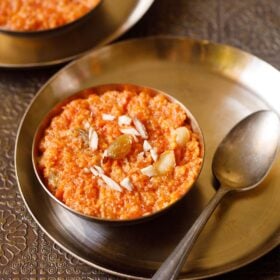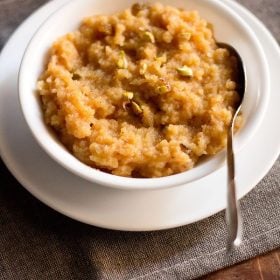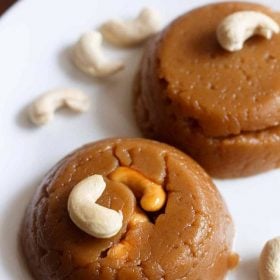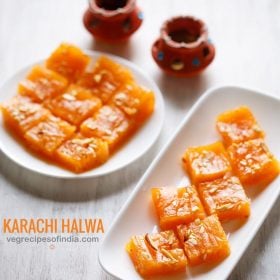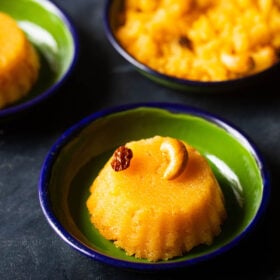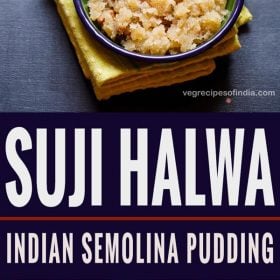Suji ka halwa is your classic everyday delicious North Indian sweet made with fine semolina or cream of wheat (farina), sugar, ghee, nuts and flavored with cardamom powder. In Maharashtra, this sweet is called as Sheera. Semolina is called as suji, sooji or rava. This easy melt-in-the-mouth halwa recipe comes together in about 15 minutes. The recipe I share is a family heirloom recipe that we have been making for decades during family get-togethers, special occasions and festivals.
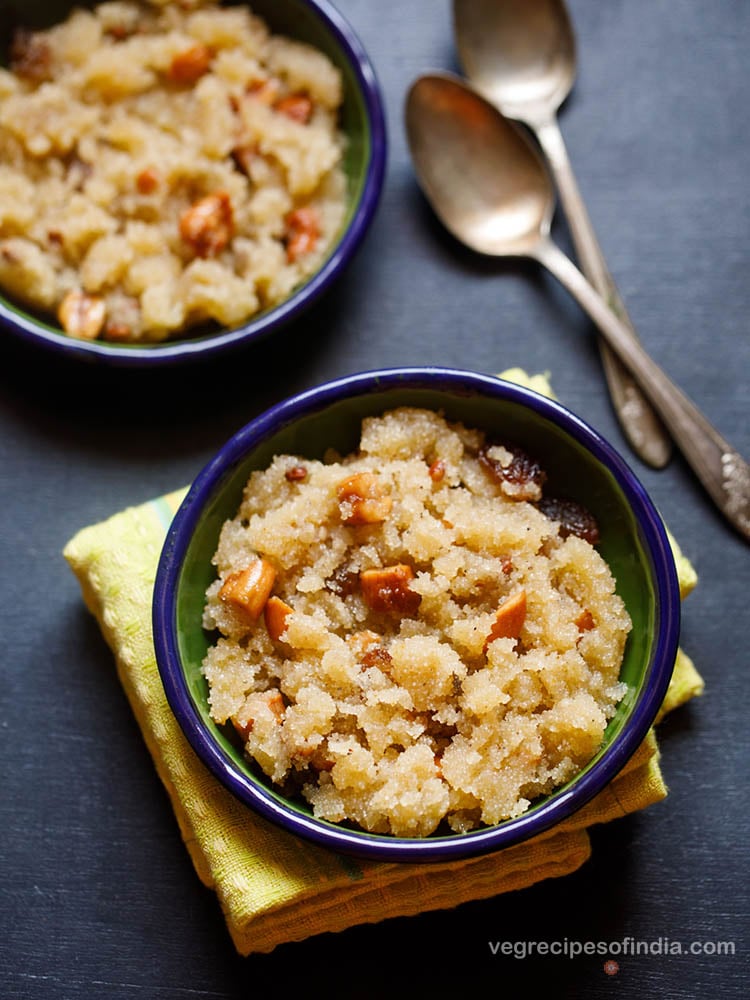
Suji ka Halwa and It’s Variations
Suji halwa is also known as Rava Sheera in Western India and Rava Kesari in South India. The method of preparation is more or less similar, with a few ingredients being changed here and there.
Though rava or semolina remains the key ingredient. In some variations, milk is added instead of water and is called as milk kesari. For flavorings usually, cardamom powder is added.
This halwa is also made for an auspicious occasion or a pooja ceremony. It could also be a festive occasion like Diwali, Ganesh Chaturthi or a religious ceremony conducted in your home or you just want to have something sweet. It also serves well as a sweet morning breakfast or an after-meal dessert.
Since this is an easy and quick halwa recipe, you don’t need any excuse or occasion to make it. I often make sooji halwa as a bhog or naivedyam to be offered to the deities.
We always make Suji halwa with puri during the Navami pooja of Navratri festival. Kala chana is also made. On this day we offer kala chana, suji halwa and puri to the small girls (kanjak) who symbolize the Mother Goddess.
The rava kesari that is popular in South India, usually has orange synthetic color added. But you can make the same, with natural coloring agents like saffron threads or saffron powder.
Saffron threads or kesar can also be added in sooji halwa like this Saffron Suji Halwa.
Along with this halwa recipe, I make other types of halwa recipes too. I don’t make them everyday, but when we have pooja or during festive occasions or sometimes just as a sweet snack.
I have shared many halwa varieties and you can check them here in this collection of 28 Halwa Recipes.
Sooji Halwa Proportions
Sooji halwa recipe is often made in bulk on festive or religious occasions. If you want to make a large quantity, then there is a certain proportion you have to follow.
The ratio of suji to sugar to water to ghee is 1:1:2:0.5 in a cup or glass measurement. I slightly deviate from this proportion and add a bit less ghee and sugar.
- Sugar – For 1 cup of sooji or rava, I add ⅔ or ¾ cup of sugar. So the suji halwa has less sweetness or is just sweet. 1 cup of sugar gives a very sweet taste.
- Ghee – I also add ⅔ cup ghee for 1 cup of suji. For me, ⅔ cup is a good amount of ghee. Reduce or increase the ghee if you prefer.
- Water – I add 2.5 cups water for 1 cup of suji. Though you can even add 2 cups of water. The amount of water can also be increased depending on the quality of the rava and if you want a pudding-like smooth consistency.
How to make Suji ka Halwa
Roast Suji or Rava
1. Heat ⅓ cup ghee in a kadai or a thick bottomed pan. Keep the heat to a low or medium-low. Use a heavy pan or else there is a risk of the suji getting burnt.
When the ghee is getting heated, at the same time keep sugar and water to boil in a pan on a different burner. Steps are mentioned below under the heading “Make Sugar Syrup“.
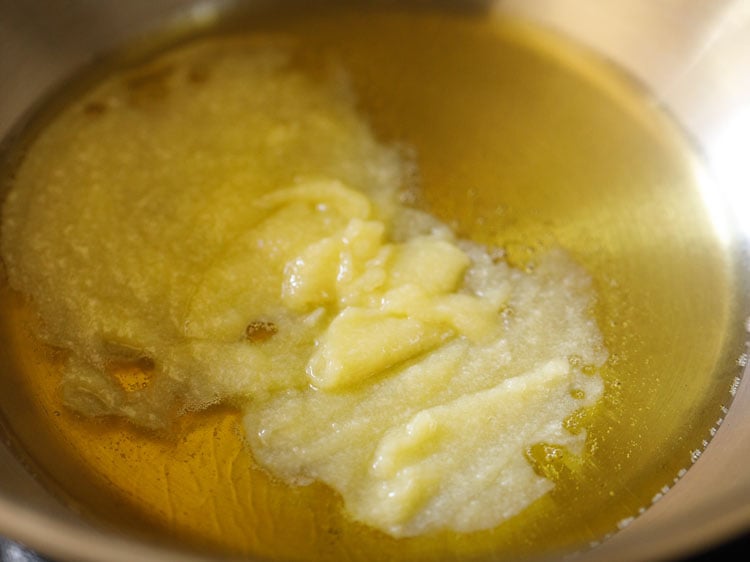
2. Add ½ cup sooji (rava or semolina). Use a fine variety of sooji and not the coarser variety.
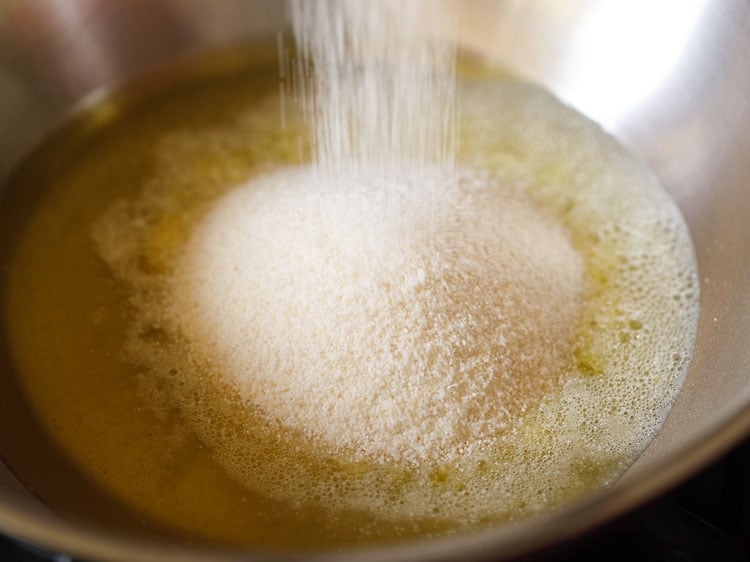
3. Also add 10 to 12 cashews halved or whole.
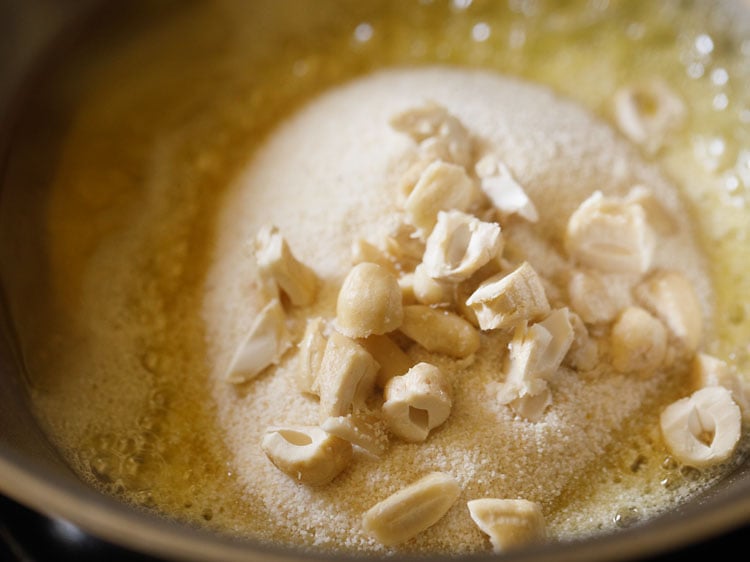
4. Mix very well and start roasting the sooji and cashews.
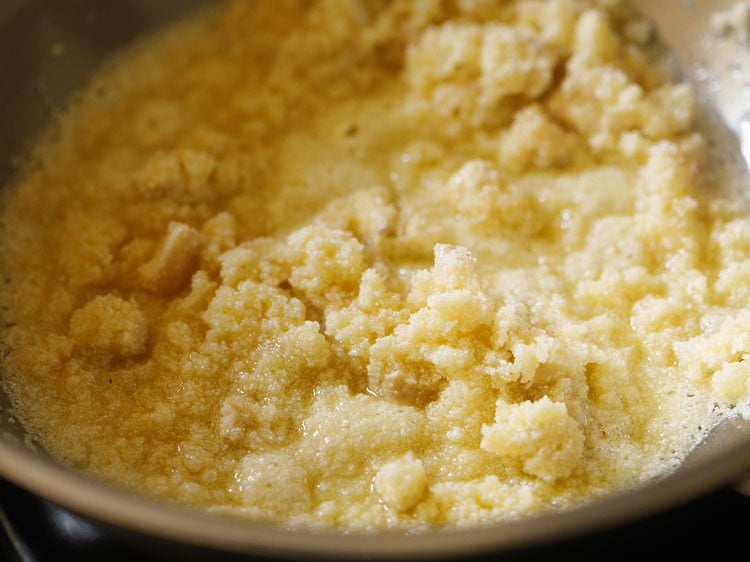
5. Keep on stirring the sooji so that the grains do not stick to the pan and are roasted evenly.
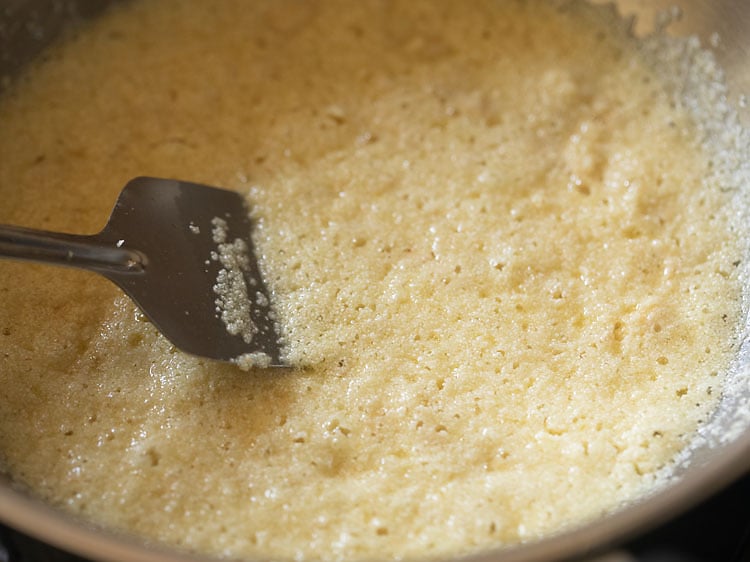
6. Roast sooji till you can see the ghee getting separated and when you see the cashews getting golden. The color of the suji or rava should not become brown. There will also be a fragrant aroma of suji and ghee in your kitchen.
Roasting suji takes approx 7 to 8 minutes on a low heat. This step is important because if sooji is not roasted well then you will not get the perfect texture in the halwa. There will be a slight raw taste in the halwa.
Handy tip – note that by the time the cashews get golden, the suji will also be roasted well. So keep on stirring and wait for the cashews to get golden.
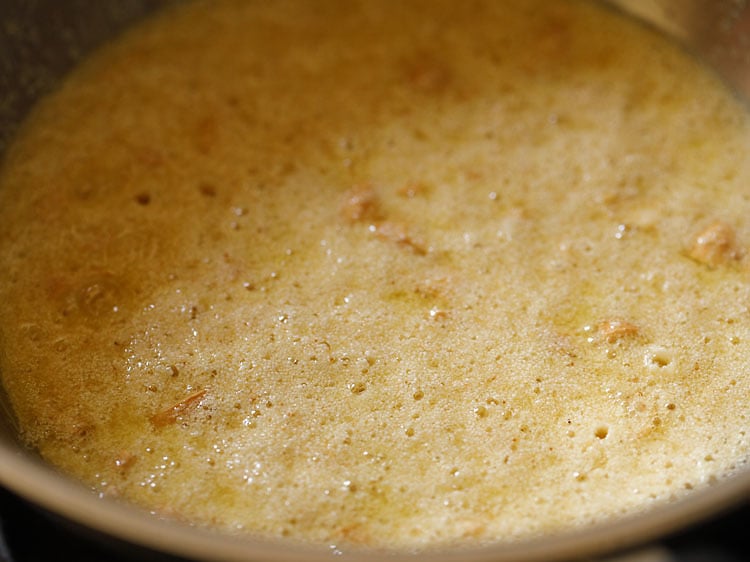
7. When the suji is roasted well, then add 1 teaspoon chironji (optional), 2 tablespoons golden raisins (kishmish) and a pinch of edible camphor (optional).
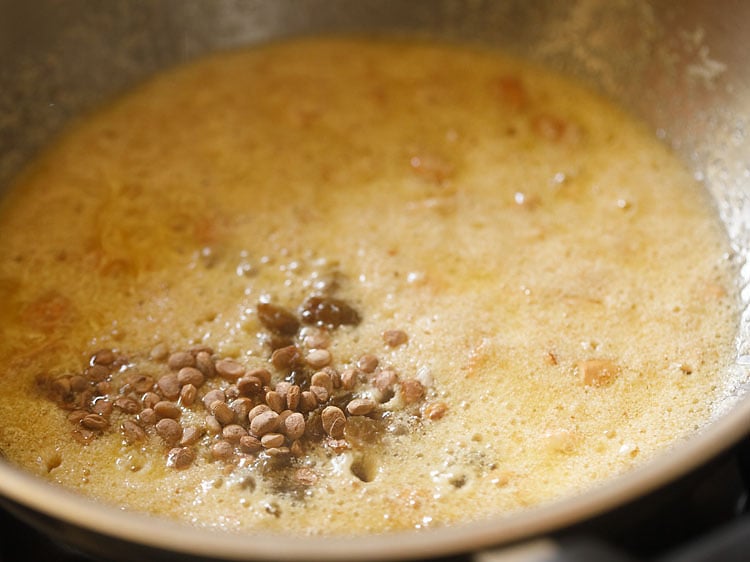
8. Next add ½ teaspoon cardamom powder (4 to 5 green cardamoms, powdered in a mortar-pestle, husks discarded). You can also add sliced almonds or pistachios.
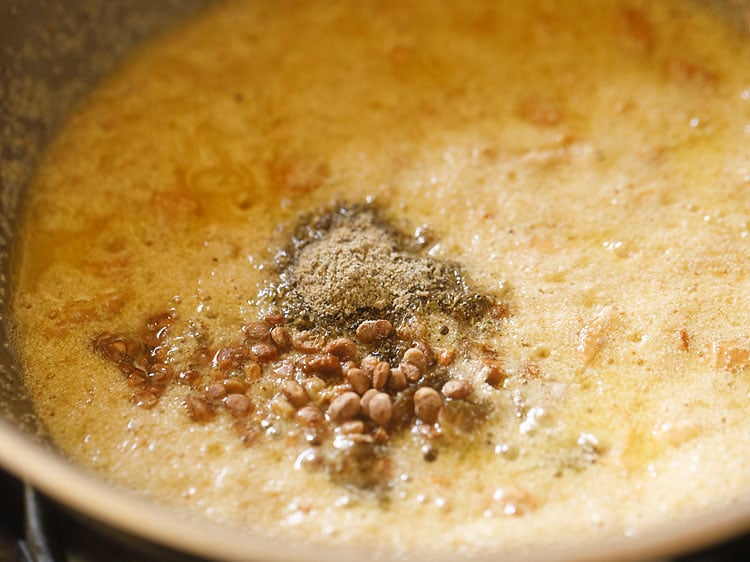
9. Mix well.
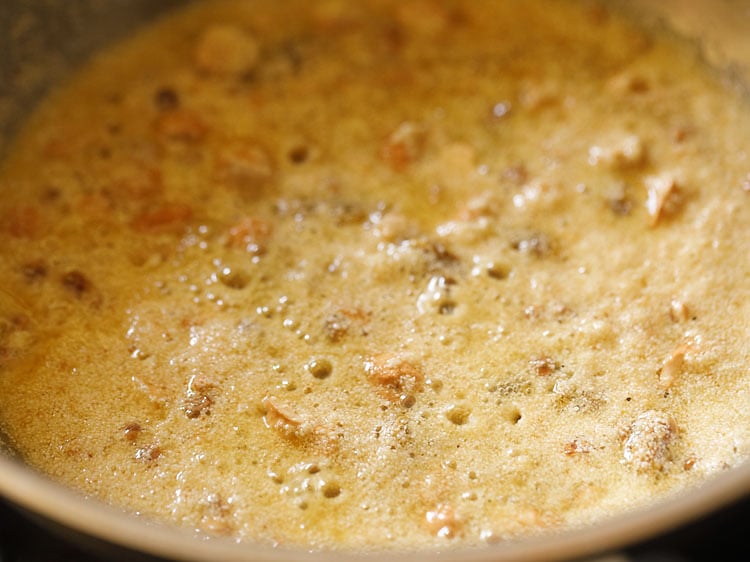
Make Sugar Syrup
10. When you keep the sooji for roasting in the ghee, at the same time, take ⅓ cup sugar in another pan or saucepan.
Here I have used raw sugar and hence the color of the water is not transparent but a light brown. I always use unrefined raw sugar in almost all of my cooking. Feel free to use white sugar in this halwa recipe. You can add the same amount of white sugar.
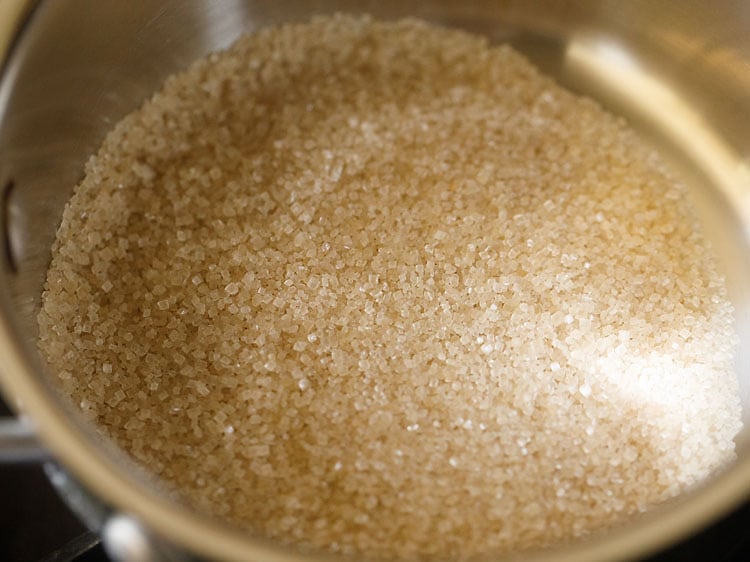
11. Pour 1.25 cups of water.
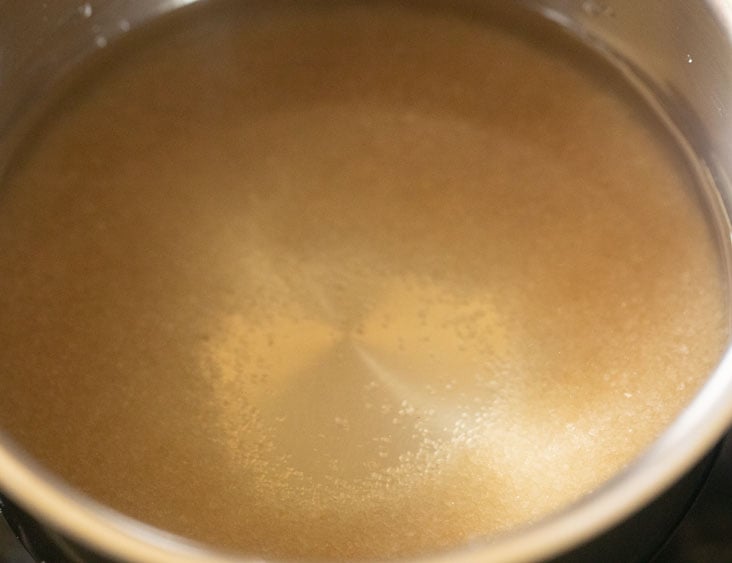
12. Keep the pan on a stovetop on medium-low to medium heat. With a spoon stir so that the sugar dissolves.
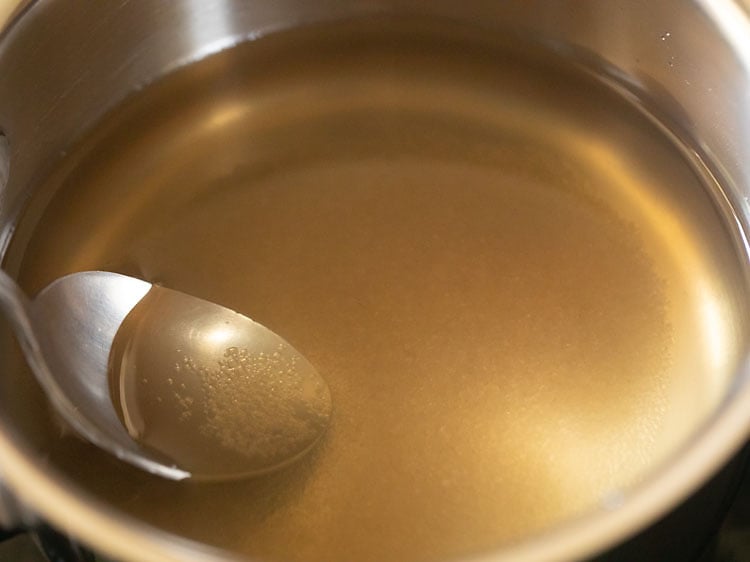
13. Bring the water+sugar solution to a boil.
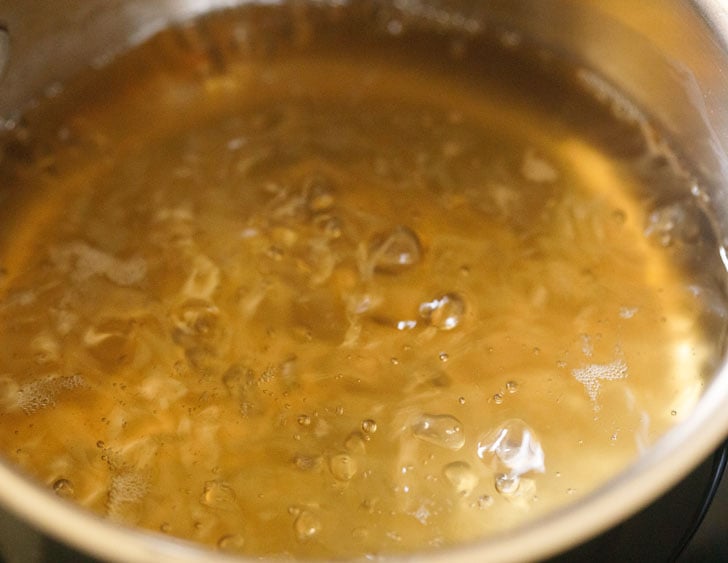
Make Halwa
14. Once you stir the raisins, cardamom powder and chironji, then pour the boiling and bubbling sugar syrup in the ghee & sooji mixture slowly, with continuous stirring.
Pour carefully, as the mixture sizzles and splutters.
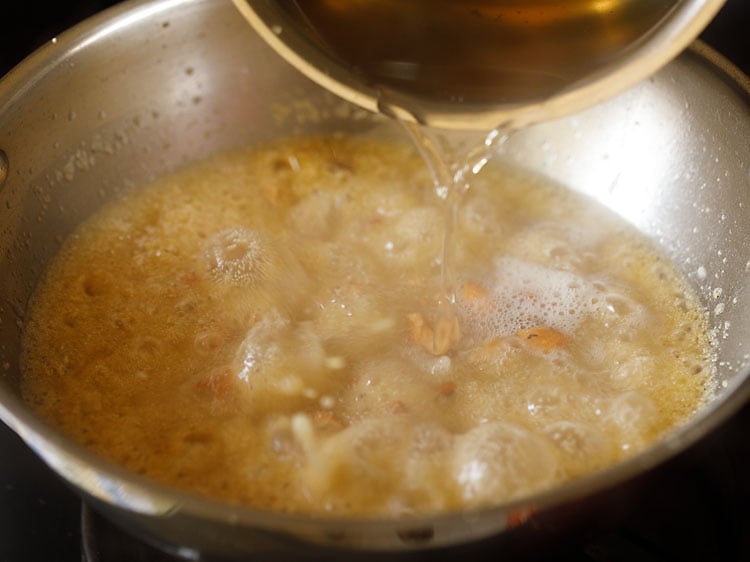
15. Mix very well so that lumps are not formed. Break the lumps if any with a spoon.
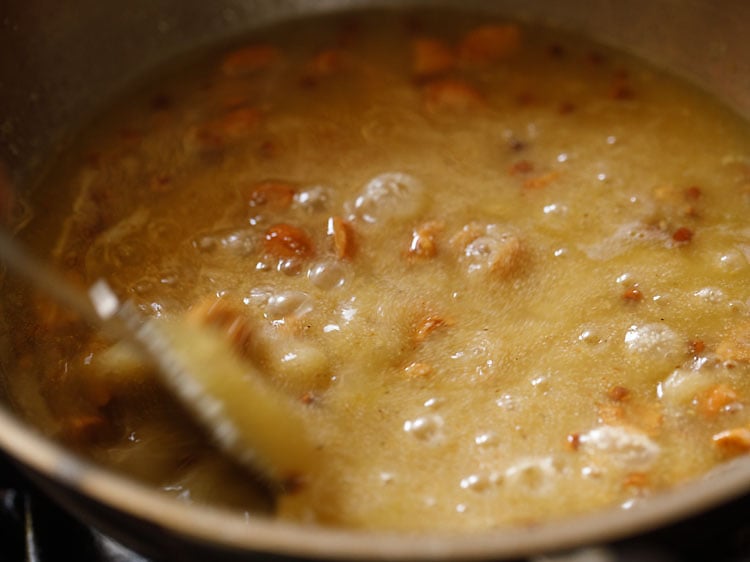
16. The sooji grains will begin to absorb the water and swell.
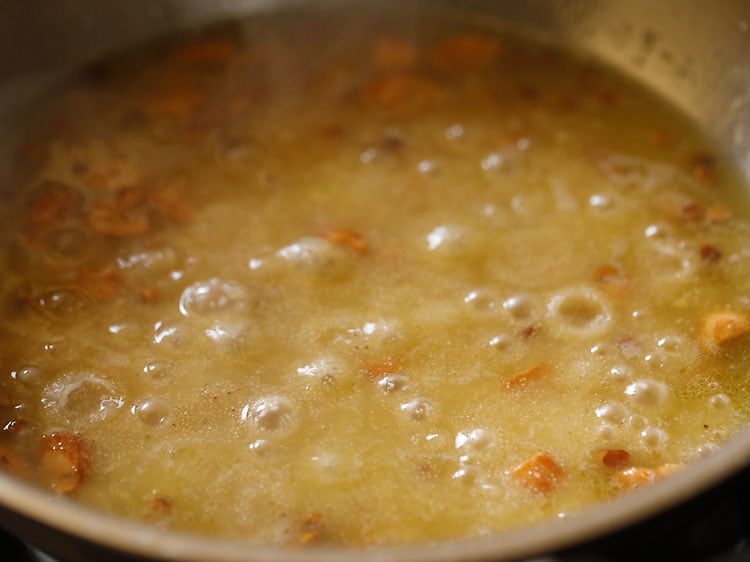
17. The mixture will start thickening. Keep on stirring often.
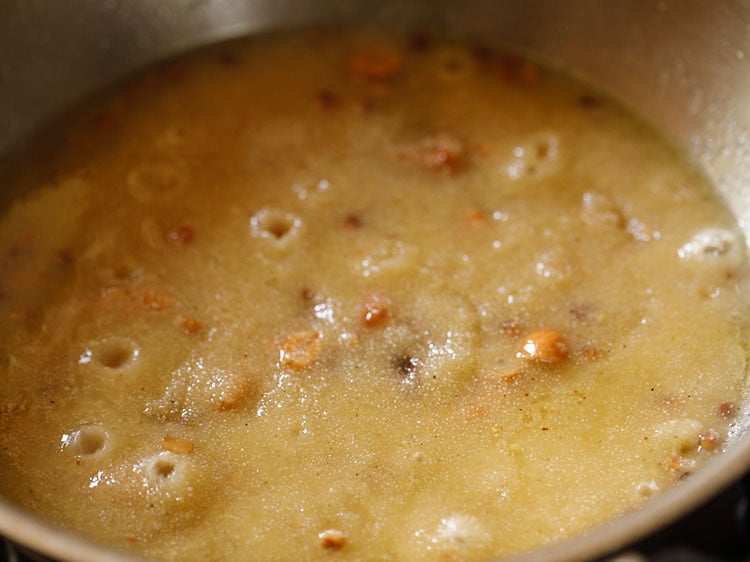
18. In the photo below, the halwa mixture has thickened but still soft, moist and the consistency is like that of pudding.
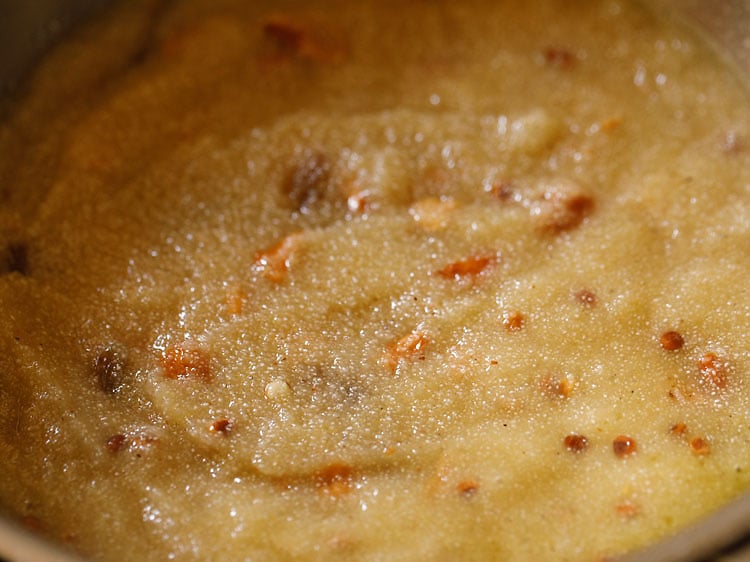
19. Once all the water is absorbed, you will notice the change in the texture. The ghee also will be visible at the sides.
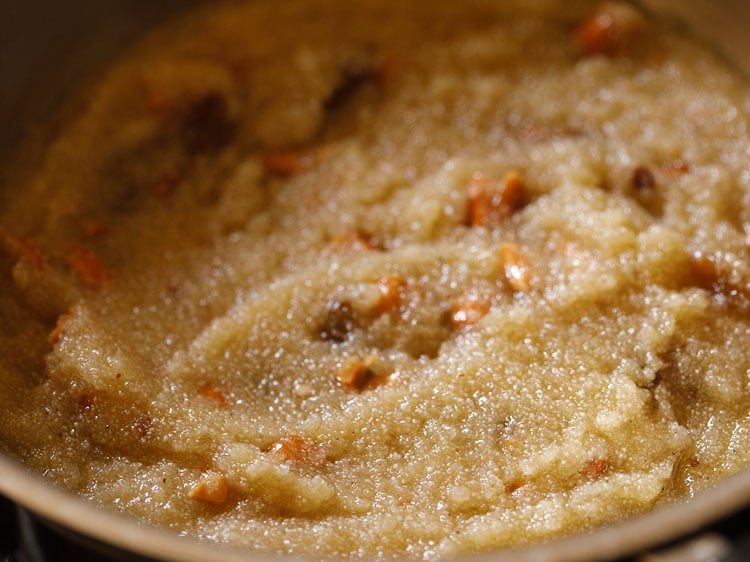
20. Keep stirring and cooking till you get the final texture of the rava sheera like the below picture. All the water should be absorbed and the halwa will leave the sides of the pan.
If you want to make slices or cubes or squares, then immediately pour the sooji halwa mixture in a greased pan or tray. Spread evenly and when warm or cooled, cut into diamond-shaped or square slices.
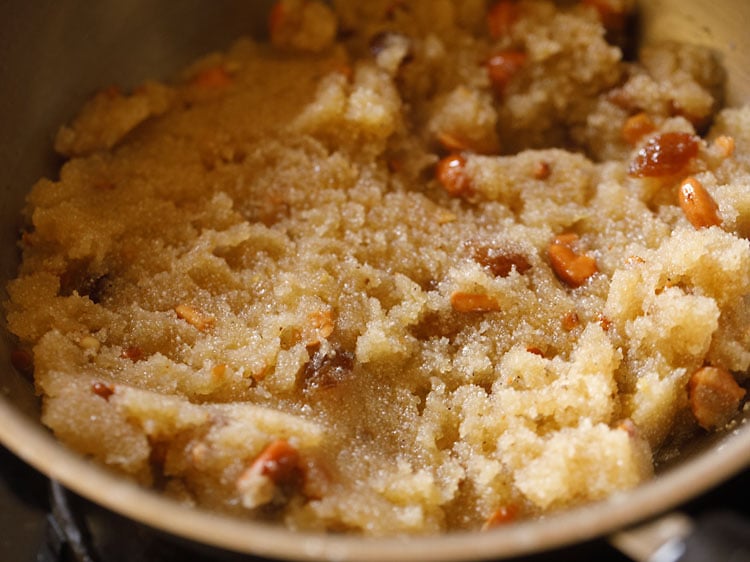
21. Serve suji ka halwa hot or warm or at the room temperature. Leftover suji halwa can be refrigerated. Before serving warm in a small pan or in a microwave.
Suji ka halwa or Sheera is usually served as a sweet snack. You can serve it after a meal. It can be paired with poori too or served as a dessert.
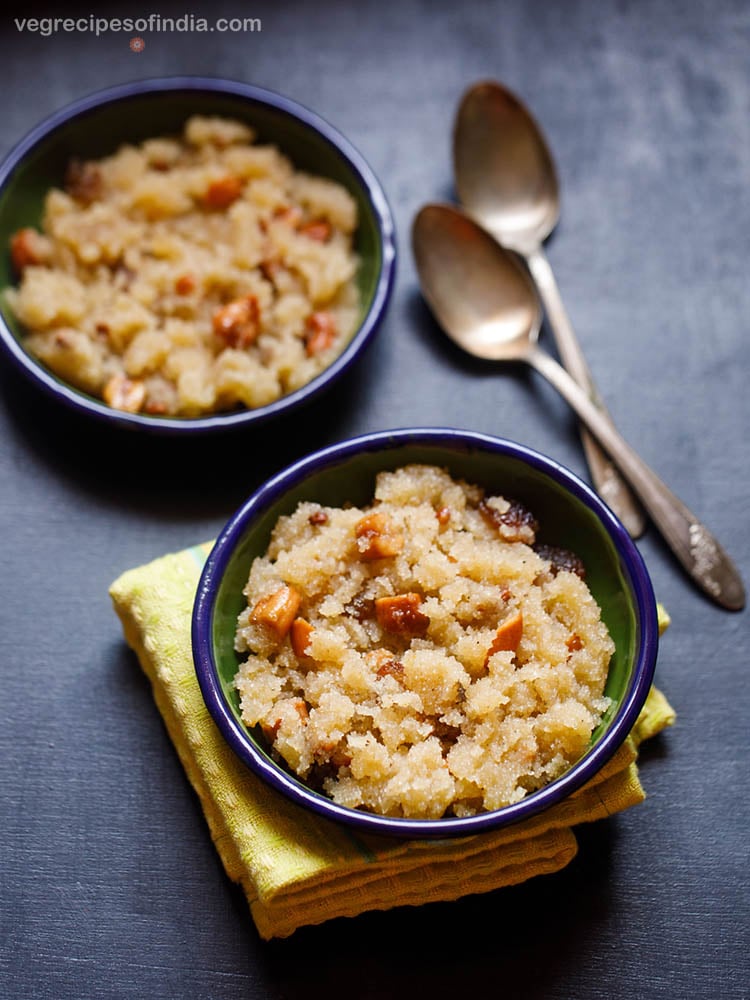
Expert Tips
- Type of suji or rava: Use the fine variety of suji for making halwa as it gives a smooth tasting halwa. You can also use Bombay rava. Ensure that your sooji is fresh and does not have any insects or molds. The sooji should be in the shelf period.
- Temperature: When adding the sugar solution to the rava, it has to be boiling and bubbling hot. If the sugar solution becomes warm, then heat it up till it comes to a boil. The roasted rava mixture also has to be hot when the sugar solution is added.
- Multi-cooking: When you begin roasting the rava, at the same time, keep the sugar solution to boil on another burner.
- Reducing Ingredients: You can reduce both the amount of sugar and ghee according to your taste preferences and health conditions.
- Sweeteners: Jaggery can be also added instead of sugar. First, add jaggery in water and heat the water till it becomes warm. When all the jaggery is dissolved, strain the solution to get rid of impurities. Put the strained solution back in the pan and heat till it comes to a boil.
- Liquids: Milk can be added instead of water and this will give the suji ka halwa rich taste and flavor.
- Flavorings: For flavoring and aroma, usually, cardamom powder is added. Variations can be 8 to 10 saffron strands soaked in some warm water or even rose water can be added.
- Dry Fruits and Nuts: You can add your choice of dry fruits and nuts. I usually add a mix of cashews, almonds, chironji and golden raisins. Sometimes I also add pistachios.
- Edible Camphor: Adding edible camphor is optional. If you are making sooji halwa for religious occasions then you can add a pinch of edible camphor. During 8th or 9th day of Navratri festival, this sooji halwa is made along with dry kala chana and pooris for kanjak pooja in parts of North India.
More Halwa Recipes!
Sweets Recipes
Halwa Recipe
Halwa Recipe
Halwa Recipe
Please be sure to rate the recipe in the recipe card or leave a comment below if you have made it. For more vegetarian inspirations, Sign Up for my emails or follow me on Instagram, Youtube, Facebook, Pinterest or Twitter.
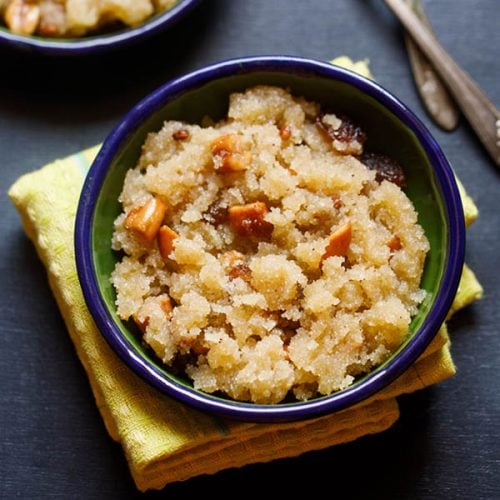
Suji ka Halwa Recipe (Sheera Recipe)
Ingredients
- ½ cup suji (fine rava or semolina or cream of wheat)
- ⅓ cup sugar or approximate 5 to 6 tablespoons sugar or add as required
- ⅓ cup Ghee – approximate 6 tablespoons of ghee
- ½ teaspoon cardamom powder – or 4 to 5 green cardamoms powdered in a mortar-pestle, husks discarded (choti elaichi powder)
- 10 to 12 cashews – halved or whole (kaju)
- 2 tablespoons golden raisins (kishmish)
- 1 teaspoon chironji – optional (charoli)
- 1.25 cups water – can also add 1 cup water
- 1 pinch edible camphor (optional)
Instructions
Preparation
- Crush the green cardamom seeds to a fine powder in a mortar-pestle and keep aside. Remove the husks
- Keep a kadai or pan on a low flame.
- Add the ghee and when the ghee is heating up, do the following.
- Take the sugar and water in another pan.
- Keep this pan on a medium to high heat and let the sugar solution come to a boil.
- Once the ghee becomes hot, add the suji (semolina) and cashews and stir.
- Keep on stirring the suji (semolina) so that the grains does not stick to the pan and are roasted evenly.
- Meanwhile keep your attention on the sugar syrup also.
- If the mixture starts to boil, then lower the heat and let it simmer.
- Keep on roasting and stirring the semolina for 7 to 8 minutes till the grains change their color and when the cashews also change to a light golden or golden.
- You have to roast sooji till you can see the ghee getting separated. The color of the suji or rava should not become brown. There will also be a fragrant aroma of suji and ghee in your kitchen.
- Remember that the roasting rava is very important. If the rava not is not roasted well then you won't get the best texture in the halwa and there will be slightly raw taste.
- Then add the cardamom powder, chironji, raisins and edible camphor (optional). Mix very well.
Making suji ka halwa or sheera
- Stir and then add the bubbling hot sugar syrup slowly to the roasted suji mixture.
- Be careful as the mixture has the tendency to splutter.
- Be quick enough to stir. The sooji will begin to absorb the water and swell.
- Keep on stirring often till the whole mixture starts thickening and starts to leave the edges of the kadai or pan.
- Serve sooji halwa hot or warm or when cooled at room temperature.
- It can be had as a sweet snack or served as a dessert after meals.
- Store any leftovers in the fridge in an air tight container for 1 to 2 days. Reheat in a pan for while serving.
Video
Notes
- Type of suji: Use the fine variety of suji for making halwa. Ensure that your rava is fresh, within its shelf period and does not have insects or mold and is not rancid.
- Scaling: Recipe can be halved or doubled or tripled.
- Edible camphor: Add a pinch of edible camphor if you are making suji halwa for religious occasions.
- Temperature: When adding the sugar solution to the rava, it has to be boiling and bubbling hot. If the sugar solution becomes warm, then heat it up till it comes to a boil. The roasted rava mixture also has to be hot when the sugar solution is added.
- Multi-cooking: When you begin roasting the rava, at the same time, keep the sugar solution to boil on another burner.
- Adding less amounts: You can reduce both the amount of sugar and ghee. For less sweet taste in rava sheera, add ¼ cup sugar.
- Sweetener: Jaggery can be also added instead of sugar. First, add jaggery in water and heat the water till it becomes warm. When all the jaggery is dissolved, strain the solution to get rid of impurities. Put the strained solution back in the pan and heat till it comes to a boil.
- Liquids: You can add milk instead of water.
- Flavorings & Nuts: You can add your choice of dry fruits and nuts. For flavoring and aroma apart from cardamom powder you can also add saffron strands or even rose water.
Nutrition Info (Approximate Values)
This Suji Halwa recipe from the blog archives was first published in July 2014. It has been updated and republished on July 2021.
